Nature Diary
Rocks
History
Gallery
Links
Home Page
   ALONG THE LANE we see two Bullfinches and two or three Greenfinches fly from the hedge to the top of an Ash tree. A few yards further on, four Chaffinches fly from the hedge to an orchard. A Wood Pigeon sits in one of the apple trees. The sun brings out the bloom on its plumage.
ALONG THE LANE we see two Bullfinches and two or three Greenfinches fly from the hedge to the top of an Ash tree. A few yards further on, four Chaffinches fly from the hedge to an orchard. A Wood Pigeon sits in one of the apple trees. The sun brings out the bloom on its plumage.
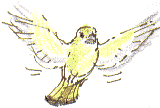  
Later we come across a fourth species of finch; a group of Goldfinches, accompanied by Blue Tits in the thorns by the canal.
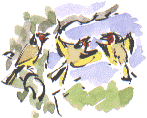 My friend Rheba Kramer, writes from The Lair, Texas;
My friend Rheba Kramer, writes from The Lair, Texas;
'Your goldfinches seem to have red or russet around the eyes. Ours don't have any red on them. In winter they are olive to yellowgreen with no black on their heads. We get them in the winter but they change into breeding plumage just before leaving in spring and I call them my wild canaries.'
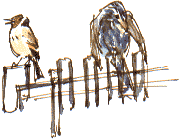 She attaches a photograph from the cover of a birding supply catalogue of the male American Goldfinch in breeding plumage. It really does resemble a canary; it's yellow all over with a small black cap and black on the tail and the primaries. In Birds of the World Oliver L. Austin explains that there are 64 species of goldfinch in Eurasia, 30 in Africa and 32 in the Americas;
She attaches a photograph from the cover of a birding supply catalogue of the male American Goldfinch in breeding plumage. It really does resemble a canary; it's yellow all over with a small black cap and black on the tail and the primaries. In Birds of the World Oliver L. Austin explains that there are 64 species of goldfinch in Eurasia, 30 in Africa and 32 in the Americas;
'In the European Goldfinch the sexes are alike the year round. In the congeneric American Goldfinch the sexes differ, and the male dons his bright-yellow and black breeding plumage in spring and doffs it in the late summer.'
(I had to look up congeneric; it means a species of the same group or genus.)
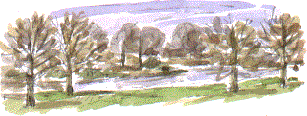 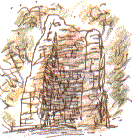 Its been a while since we visited Thornhill Park. It's good to see the parkland again, especially with the beams of low winter sunshine which pick out individual trees. A grassy slope rolls down to trees around the old moat. Very restful, very English. At least it's peaceful now; the Hall, which stood on the island, was blown up, apparently by accident, during a Civil War siege. Today a young man is builds a small fire by the ruins of the chimney.
Its been a while since we visited Thornhill Park. It's good to see the parkland again, especially with the beams of low winter sunshine which pick out individual trees. A grassy slope rolls down to trees around the old moat. Very restful, very English. At least it's peaceful now; the Hall, which stood on the island, was blown up, apparently by accident, during a Civil War siege. Today a young man is builds a small fire by the ruins of the chimney.
  The temporary flood in a field between the canal and the river, which I sketched (left) on the 11th December, has now subsided. Instead of Black-headed Gulls paddling there today a Redshank is standing in the puddle that remains, probing the mud. It flies off calling over the flood embankment and down to the river.
The temporary flood in a field between the canal and the river, which I sketched (left) on the 11th December, has now subsided. Instead of Black-headed Gulls paddling there today a Redshank is standing in the puddle that remains, probing the mud. It flies off calling over the flood embankment and down to the river.


Richard Bell,
wildlife illustrator
E-mail; 'richard@daelnet.co.uk'
Next day
Previous day
Nature Diary
Wild West Yorkshire home page
|


 ALONG THE LANE we see two Bullfinches and two or three Greenfinches fly from the hedge to the top of an Ash tree. A few yards further on, four Chaffinches fly from the hedge to an orchard. A Wood Pigeon sits in one of the apple trees. The sun brings out the bloom on its plumage.
ALONG THE LANE we see two Bullfinches and two or three Greenfinches fly from the hedge to the top of an Ash tree. A few yards further on, four Chaffinches fly from the hedge to an orchard. A Wood Pigeon sits in one of the apple trees. The sun brings out the bloom on its plumage.



 My friend Rheba Kramer, writes from
My friend Rheba Kramer, writes from  She attaches a photograph from the cover of a birding supply catalogue of the male American Goldfinch in breeding plumage. It really does resemble a canary; it's yellow all over with a small black cap and black on the tail and the primaries. In Birds of the World Oliver L. Austin explains that there are 64 species of goldfinch in Eurasia, 30 in Africa and 32 in the Americas;
She attaches a photograph from the cover of a birding supply catalogue of the male American Goldfinch in breeding plumage. It really does resemble a canary; it's yellow all over with a small black cap and black on the tail and the primaries. In Birds of the World Oliver L. Austin explains that there are 64 species of goldfinch in Eurasia, 30 in Africa and 32 in the Americas;
 Its been a while since we visited Thornhill Park. It's good to see the parkland again, especially with the beams of low winter sunshine which pick out individual trees. A grassy slope rolls down to trees around the old moat. Very restful, very English. At least it's peaceful now; the Hall, which stood on the island, was blown up, apparently by accident, during a Civil War siege. Today a young man is builds a small fire by the ruins of the chimney.
Its been a while since we visited Thornhill Park. It's good to see the parkland again, especially with the beams of low winter sunshine which pick out individual trees. A grassy slope rolls down to trees around the old moat. Very restful, very English. At least it's peaceful now; the Hall, which stood on the island, was blown up, apparently by accident, during a Civil War siege. Today a young man is builds a small fire by the ruins of the chimney.
 The temporary flood in a field between the canal and the river, which I sketched (left) on the
The temporary flood in a field between the canal and the river, which I sketched (left) on the 